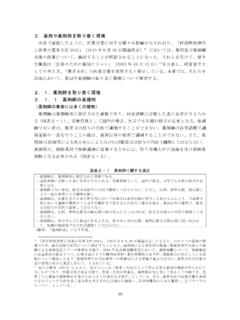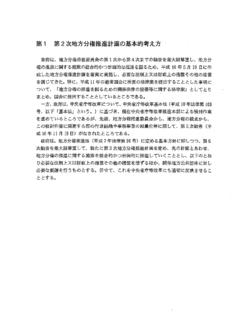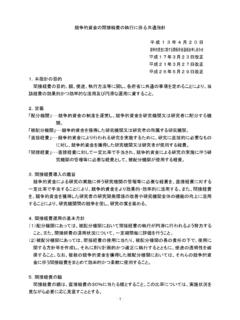Transcription of Provisional Translation - cao.go.jp
1 Provisional Translation Basic Policy on Economic and Fiscal Management and Reform 2017 June 9, 2017 Cabinet Decision Basic Policy on Economic and Fiscal Management and Reform 2017 is as described in the Attachment. (Attachment) Basic Policy on Economic and Fiscal Management and Reform 2017 Increasing productivity through investment in human resources June 9, 2017 Basic Policy on Economic and Fiscal Management and Reform 2017 (Table of contents) Chapter 1 Current situation, challenges and policies for the Japanese economy--------------------------------- ---------------------------------------- ------------------- 1 1. Current situation and challenges of the Japanese economy (1) The current situation of the Japanes e econom y and governm ent initiatives to r ealize a Society in Which All Citizens are Dynamically Engaged (2) Realization of the virtuous cycle of growth and distribution through work style r eform (3) Inc r easing pr oductivity through investment in human r esources (4) Regional revitalization (5) Boosting consumption and private investment 2.
2 Reconstruction from the Great East Japan Earthquake, etc. (1) Reconstr uction and r evitalization after the Gr eat E ast Japan E ar thquake 1) Initiatives during the second year of the "Reconstruction and Revitalization Period" 2) Reconstruction and r evitalization after the nuclear disaster (2) Responses to the Kumamoto Earthquakes Chapter 2 Priority issues for the expansion of a virtuous cycle of growth and distribution and for mid- to long-term development------------------------ 7 1. The r ealization of a soc iety w hose citizens play active r oles thr oughout their lives thr ough work s tyle r eform and investment in human r esources (1) Work Style reform 1) Impr ovem ent in the w or king c onditions of non-r egular w or kers suc h as by providing equal pay for equal work 2) Im pr ovement in long working hours 3) Promotion of Flexible Work Styl es 4) Balancing tr eatment for an illness, child-r aising, or car e of the elderly with w or k; promoting employment for those with disabilities 5) Ac c eptance of Foreign Workers 6) Suppor t for C ar eer C hange or Reemploym ent O ppor tunities to Industries w ith the Capacity to Absorb a Large Amount of Employment 7) Pr epar ation of an envir onm ent w hich facilitates the active par tic ipation of young people.
3 Promotion of employment for seniors (2) Human resource investment and education 1) Drastic reinforcement of investment in human resources 2) Improvement of the quality of education, etc. 3) Promotion of recurrent education, etc. (3) Measures to address the falling birthrate, support for children and child-raising (4) Promotion of women's participation and advancement in the workplace 2. Acceleration of growth strategies, etc. (1) Initiatives aiming at the realization of Society 1) Strategic areas 2) Cross-cutting issues (2) Measures to improve pr oductivity 1) Develop the national movement to improve productivity 2) Strengthening of corporate governance (3) Encouragement of investment 1) Innovation promotion 2) Encouragement of foreign direct investment in Japan (4) Promotion of regulatory reform 1) Promotion of National Strategic Special Zones 2) Initiatives to reduce the cost of government pr ocedures (5) Generation and expansion of new markets which promise growth 1) A C ultur al and Ar tistic Nation 2) A Sports Nation 3) Promotion of clean and attractive "Japanese IR" (Integrated Resort) development (6) Strengthening of partnerships with overseas growth markets 1) E s tablishment of global value chains 2) Encouragement of strategic exports and tourism 3.
4 R evitalization of c onsumption (1) Inc r easing disposable income (2) Boosting new demand 1) Boosting demand in the health and prevention fields 2) Revitalization of tourism and travel consumption 3) Initiatives in pr eparation for hosting the 2020 Tokyo Olym pic and Paralympic Games, etc. 4) Encouragement of the use of Premium Friday 5) E ffective utilization of stock 4. Regional r einvigoration, support for small and medium enterpris es and small-scale entrepreneurs (1) Regional reinvigoration (2) Aggressive development of agriculture, forestry, and fisheries (3) Support for SMEs and microenterprises (4) R egional revitalization 1) Initiatives for regional revitalization 2) Developing Okinawa 3) D ec entr alization r eform, etc. 4) Improvement of urban vitality (5) National res ilience, disaster control, and public investm ents prior itized to enhance growth potential 1) National resilience 2) Disaster prevention and reduction 3) Public investments prioritized to enhance growth potential 5.
5 Securing the foundations of a safe and secure life and economic society (1) Diplomacy and security 1) Diplomacy 2) S ec ur ity (2) Public order and consumer affairs 1) P ublic order, administr ation of justice, crisis management, etc. 2) Consumer affairs (3) Initiatives for the creation of a society based on m utual assistanc e and peac eful coexistence (4) Resources and energy (5) Contribution to the global environment (6) P r omotion of statistics r eforms Chapter 3 Progress towards and promotion of reform for economic and financial integration----------------------------- ---------------------------------------- ---- 46 1. Steady promotion of reform for economic and financial integration 2. Cross-cutting issues for reform (1) Promotion of "Visualization," nationw ide dissemination of advanced and exc ellent practices, and wise s pending 1) Thorough implementation and expansion of "visualization" with more comparability 2) Encouragement of nationwide dissemination of advanced and excellent practices 3) Thorough implementation of wise spending (2) Promotion of Evidence Based Policy Making through the preparation of data platforms (3) Formulation and implementation of an outlook for the future 3.
6 Reform initiatives in each key area (1) Social security 1) B as ic thinking 2) Realization of the community health c are vision, formulation of consistent medic al care plans and insured long-term care service plans, etc. 3) Optimization of medical costs 4) Health promotion, promotion of preventive measures, etc. 5) FY 2018 revision of medical service and long-term care fees, etc. 6) Long-term care insurance system, etc. 7) Radical reform of the dr ug pr icing s ystem, revision of dis pensing fees for the r ealization of the patient-center ed s epar ation of medical and dispens ar y prac tice, proper use of drugs, etc. 8) End-of-life c are 9) Revision of the public assistance system and the self-reliance of the needy (2) Social Infrastructure development 1) Guiding principles 2) Promotion of the C ompact P lus Network 3) Provision of appropriate public capital stock and smart infrastructure management 4) Effective utilization of land without a readily-identifiable ow ner, land w hich has been underutilized, vacant houses, etc.
7 5) Promotion of PPP/PFI 6) Promotion of prioritizing and streamlining and the securing those responsible for w or k (3) Local public administration and finance, etc. 1) Guiding Principles 2) Pr omotion of the administr ative and fiscal reforms through "visualiz ation" of r egional disparities between local government services, etc. 3) Reforms of local allocation tax and other fiscal systems of local governments 4) Promotion of wider-area/joint s ervices and operational reforms, etc. 5) Impr oving the efficiency of national and local gover nments, wider use of IT, and operational reforms (4) Education, science and technology (5) R eforming revenue m easures, and c ompr ession of assets and liabilities 1) Revenue reform 2) C om pr ession of assets and liabilities Chapter 4 Short-term principles in economic and fiscal management and guiding principles in budget formulation for FY 2018 -------------------------- 68 1.
8 The current state of the economy, forthcoming trends, and ways of thinking about im m ediate economic and financial management 2. Guiding principles in compiling the budget for FY 2018 (1) Steady implementation of the "Plan to Advance E conomic and Fiscal Revitalization" (2) Guiding principles in budget formulations for FY 2018 1 Chapter 1 Current situation, challenges and policies for the Japanese economy 1. Current situation and challenges of the Japanese economy (1) The current situation of the Japanese economy and government initiatives to realize a Society in Which All Citizens are Dynamically Engaged Thanks to four and a half years of Abenomics, the nominal GDP and corporate profits are at a record high level. Employment conditions, which closely relate to people s lives, have significantly improved. The number of employed people has risen by million.
9 The number of regular employees, w hich star ted r ising two years ago for the first time in eight years, has increased by 790,000 over the past two years, exceeding the increase in non-regular employees. The active job openings-to-applicants r atio stands above times in all 47 prefectures for the first time in history, and the unemployment rate is , the lowest in 22 years. Wages maintain their rising trend over the last three years, with many firms raising their base pay for the fourth consecutive year in this spring's labor-management wage negotiations. As the employment and income situation is significantly improving, a positive economic cycle is steadily beginning to turn nationwide. With regard to the outlook, the moderate recovery is expected to continue, although uncertainty regarding developments in overseas economies and the influence of fluctuations in the financial and capital markets warrant close attention.
10 Since last year, the government has worked to realize a Society in Which All Citizens are Dynamically Engaged, in order to overcome the structural issue of the falling birthrate and aging society. The government ensures that the positive economic cycle created by Abenomics does not end up as a temporary phenomenon but develops into a virtuous cycle of growth and distribution, where wealth generated by growth is widely shared by the citizens, by continuously pr omoting the New three arr ows in an integr ated manner, which consist of the realization of a 600 trillion yen economy, the des ir able birthrate of , and no one forced to leave their jobs for nursing care. As the perception of labor shortage heightens in the regions, the government works to deliver the virtuous cycle to every corner of the country. (2) Realization of the virtuous cycle of growth and distribution through work st yle re form While the employment and income s ituation is improving, the Japanese economy faces challenges including low growth potential, sluggish consumption due to c oncerns regarding the future, and decreasing vitality of the middle class.












